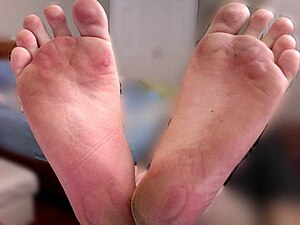 |
| Friction Blisters on Human foot due to running barefoot. (Photo credit: Wikipedia) |
The bottom line is that foot health is extremely important and needs to be a priority. If you are interested in barefoot running, you need to know the facts being given on both sides and make an educated decision that ultimately will keep feet safe in the long run.
The Pro’s
Some studies have shown that barefoot running can actually prevent injury and improve and enhance a runner’s stride. Supporters suggest that it encourages you to land on your forefoot, which helps strengthen your arch as a shock absorber. Barefoot running may work smaller muscles in your body that help improve balance and also strengthen muscles and ligaments in feet.
The Con’s
The underlying negative is that barefoot running can put foot health at risk. Feet can be exposed to dangerous debris such as glass and sharp rocks. Blisters and calluses can form from running without protective cushioning. Common injuries seen in podiatric offices from barefoot running include plantar fasciitis, Achilles strain and abrasions.
Before your bare feet hit the pavement, listen to trusted experts such as Dr. Tina Boucher, foot and ankle specialist in Meriden, CT. She can provide a thorough foot analysis and help decide if this activity is right for your foot health. To schedule an appointment or find further information, call our office at (203) 238-3668 or visit us at www.centralctfootcare.com.




No comments:
Post a Comment